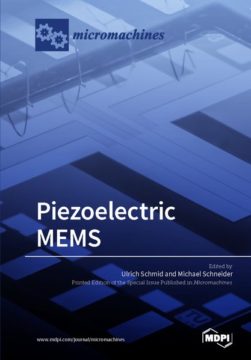Electromechanical transducers based on piezoelectric layers and thin films are continuously finding their way into micro-electromechanical systems (MEMS). Piezoelectric transducers feature a linear voltage response, no snap-in behavior and can provide both attractive and repulsive forces. This removes inherent physical limitations present in the commonly used electrostatic transducer approach, while maintaining beneficial properties such as low-power operation. In order to exploit the full potential of piezoelectric MEMS, interdisciplinary research efforts range from investigations of advanced piezoelectric materials over the design of novel piezoelectric MEMS sensor and actuator devices, to the integration of PiezoMEMS devices into full low-power systems. In this Special Issue, the current status of this exciting research field will be presented, covering a wide range of topics including, but not limited to:
• Experimental and theoretical research on piezoelectric materials such as AlN, ScAlN, ZnO or PZT, PVDF with a strong focus on the application of MEMS devices.
• Deposition and synthesis techniques for piezoelectric materials enabling integration of those materials into MEMS fabrication processes.
• Modelling and simulation of piezoelectric MEMS devices and systems.
• Piezoelectric MEMS resonators for measuring physical quantities such as mass, acceleration, yaw rate, pressure and viscosity or density of liquids.
• Optical MEMS devices, such as scanning micro mirror devices and optical switches, based on piezoelectric MEMS.
• Acoustic devices, such as SAW, BAW or FBARs and acoustic transducers, based on piezoelectric MEMS, such as microphones or loudspeakers.
• Piezoelectric energy harvesting devices.
• Specific packaging aspects of piezoelectric devices and systems.
• Low and zero power systems, featuring low-power sensors combined with energy harvesting devices, at least one of which is based on piezoelectric MEMS.
- Veröffentlicht am Freitag 8. Juni 2018 von MDPI
- ISBN: 9783038970057
- 168 Seiten
- Genre: Natur, Naturwissenschaft, Sachbücher, Technik
